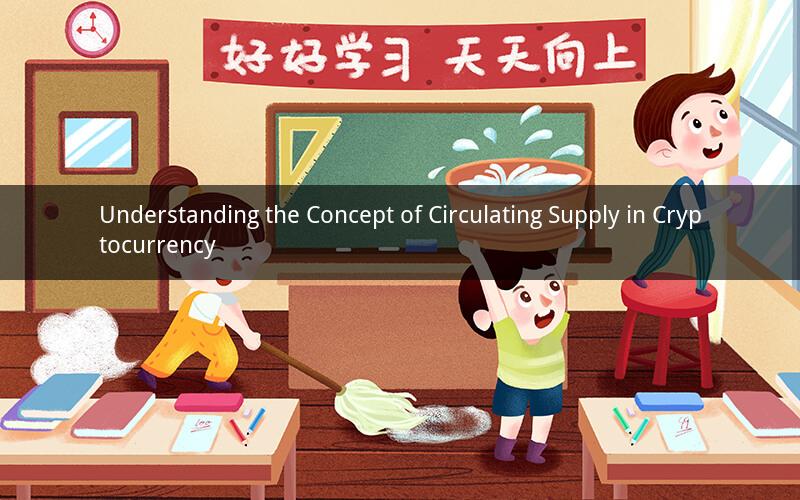
In the ever-evolving world of cryptocurrency, one term that often comes up is "circulating supply." But what exactly does it mean? This article delves into the concept of circulating supply, its significance in the cryptocurrency market, and how it differs from total supply. Additionally, we will explore the factors that affect circulating supply and its impact on the value of cryptocurrencies.
1. What is Circulating Supply?
Circulating supply refers to the total number of coins or tokens that are currently in circulation and available for use within a cryptocurrency network. Unlike the total supply, which represents the maximum number of coins that can ever be created, the circulating supply only includes coins that are actively being traded and used by users.
2. The Importance of Circulating Supply
Understanding the circulating supply is crucial for several reasons:
a. Market Capitalization: The market capitalization of a cryptocurrency is calculated by multiplying its current price by its circulating supply. This figure provides a good indication of the cryptocurrency's overall value in the market.
b. Scarcity: A lower circulating supply often suggests higher scarcity, which can lead to increased demand and potentially higher prices.
c. Supply and Demand: The circulating supply plays a significant role in determining the supply and demand dynamics of a cryptocurrency. If the circulating supply is high, it may lead to a decrease in demand and price. Conversely, a lower circulating supply may result in higher demand and price.
3. Difference Between Circulating Supply and Total Supply
It is essential to differentiate between circulating supply and total supply:
a. Circulating Supply: As mentioned earlier, this represents the number of coins or tokens currently in circulation.
b. Total Supply: This refers to the maximum number of coins or tokens that can be created, including those that are already in circulation and those that may be locked or reserved for future distribution.
4. Factors Affecting Circulating Supply
Several factors can influence the circulating supply of a cryptocurrency:
a. Token Locking: Some cryptocurrencies implement token locking mechanisms, where a portion of the coins are locked for a specific period. This can temporarily reduce the circulating supply.
b. Token Burn: Some projects periodically burn a portion of their tokens, effectively reducing the circulating supply and potentially increasing the value of the remaining tokens.
c. New Token Releases: The release of new tokens into the market can increase the circulating supply, affecting the supply and demand dynamics.
5. Impact of Circulating Supply on Cryptocurrency Value
The circulating supply can have a significant impact on the value of a cryptocurrency:
a. Scarcity: A lower circulating supply can lead to increased scarcity, which may drive up demand and prices.
b. Market Capitalization: The market capitalization, which is influenced by the circulating supply, provides an indication of the cryptocurrency's overall value in the market.
c. Supply and Demand: The supply and demand dynamics influenced by the circulating supply can lead to price fluctuations in the cryptocurrency market.
Frequently Asked Questions:
1. What is the difference between total supply and circulating supply?
Answer: Total supply refers to the maximum number of coins or tokens that can be created, while circulating supply represents the number of coins or tokens currently in circulation.
2. How does the circulating supply affect the value of a cryptocurrency?
Answer: A lower circulating supply can lead to increased scarcity, which may drive up demand and prices, while a higher circulating supply may result in decreased demand and prices.
3. Can the circulating supply of a cryptocurrency be increased?
Answer: Yes, the circulating supply can be increased through new token releases or other mechanisms implemented by the cryptocurrency project.
4. What is token locking, and how does it affect the circulating supply?
Answer: Token locking refers to the process of locking a portion of the coins for a specific period, reducing the circulating supply temporarily.
5. How can a cryptocurrency project reduce its circulating supply?
Answer: A cryptocurrency project can reduce its circulating supply through token burning, where a portion of the tokens are permanently destroyed, effectively reducing the supply in circulation.
In conclusion, understanding the concept of circulating supply in cryptocurrency is crucial for investors and enthusiasts alike. By analyzing the circulating supply, one can gain insights into the market capitalization, scarcity, and supply and demand dynamics of a cryptocurrency. As the cryptocurrency market continues to evolve, keeping an eye on the circulating supply will be essential for making informed decisions.